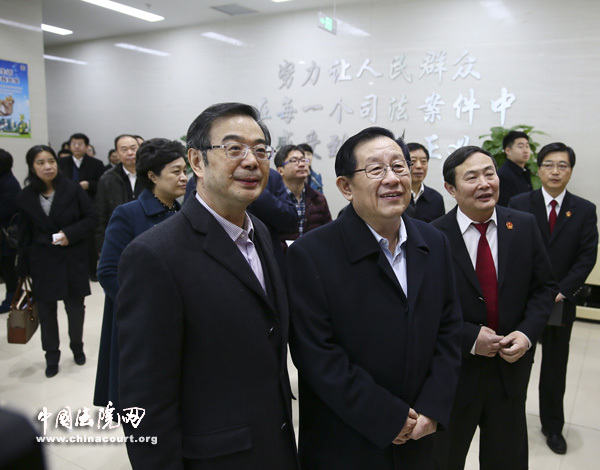Joint efforts in IPR protection to support China’s innovation-driven development

President of the Supreme People’s Court Zhou Qiang and Minister of Science and Technology Wan Gang visited the Beijing Intellectual Property (IP) Court, China’s first IP court, on Feb 25.
Wan praised the people’s courts, especially IP courts, for their roles in promoting innovation and enhancing the protection of intellectual property rights (IPRs). He required science and technology departments to step up support for and coordination with the judicial system and work together to strengthen China’s IPR protection and back its innovation-driven development.
Wan said reform in the case-filing system has shown apparent effects and fully guaranteed the rights of litigants to appeal. He also praised self-service terminals at the Beijing court that allow litigants to inquire about case processes, court notices and judgments, saying the measure helps offer convenient judicial services to the people and boosts judicial transparency.
The officials also visited the court’s “volunteers’ home”, which has attracted more than 40 volunteers from colleges and universities. They encouraged the volunteers to continue to make contributions as well as take the opportunity to improve their skills to better serve the general public.
Zhou and Wan also attended a trial of the case brought by Xi’an Iwncomm, a leading supplier for Internet and information infrastructure security technology solutions,against Sony Mobile Communications (China) over a patent dispute. Su Chi, president of the Beijing IP court, was the chief judge of the one-and-a-half-hour hearing. Assisted by technological investigators, the judges probed the alleged patent infringement and announced that another trial will be held to decide civil liabilities.
A seminar presided over by Zhou followed, at which Su made a report on the IP court’s work and attendees discussed enhancing trials of IPR cases.
With China’s ongoing judicial reform, the establishment of IP courts marked a new stage in the country’s IPR protection, Zhou said. Since their foundings more than a year ago, IP courts in Beijing, Shanghai and Guangzhou have won the public’s favor with their outstanding accomplishments, he said.The Beijing IP court has been exploring IPR trials, which is of great significance to promoting innovation-driven development, he added.
Zhou encouraged IP courts to play a pioneering role in improving IPR trials as well as reforming operation mechanisms of judicial power and personnel management, and to accumulate experience for China’s judicial reform. He also urged courts to take the lead in deeply integrating information technology and trial work and to give full play to the roles of technological investigators and experts from think-tanks.
In his address to the seminar, Wan said Chinese courts at various levels have given full play to their trial functions and intensified efforts in IPR protection, thus providing effective protection over the lawful rights of entities involved in scientific and technological innovation. In particular, IP courts have helped regulate and guide technological innovation through patent, trademark, copyright and other trials, and also have contributed to boosting the country’s entrepreneurship and innovation, he added.
The judicature is the most effective and credible means to protect scientific and technological innovation and plays an important role in upholding justice and promoting the healthy development of the innovation market, Wan stated.
A fair and efficient judicial system is needed to protect IPRs, transfer of technological achievements and innovators’ legitimate rights, Wan said. Moreover, a fair and healthy innovative market needs the timely and powerful judicial protection of technological and commercial knowhow along with a lawful curb on unfair competition and monopoly that may hinder innovation, he said.
The judicature can also ensure that innovative entities have equal access to resources, Wan said. Courts’ proper handling of various disputes concerning technological contracts, labor and personnel affairs through litigation can guide and support enterprises’ efforts in enhancing research and development, promote integration of industries, education and research and optimize the rational distribution of talents in science and technology, he added.
Wan stressed that science and technology authorities should enhance coordination with the court system and work closely to promote the implementation of China’s innovation-driven development strategy. Regular communication mechanisms are needed for joint tracking of the latest developments and new issues in the field of innovation. Analysis of litigation trends in key innovative technologies may have major implications, he noted.
He also called for building digital smart courts to bolster the effort to realize modernization of trial capabilities and systems.









